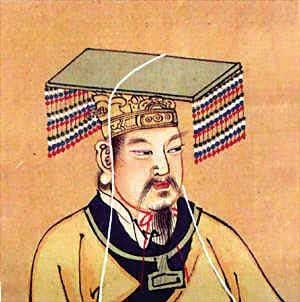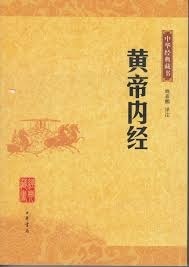Myths and Legends
(7) Wisdom of the Yellow Emperor
 In the mythical times of Yandi (炎帝), a child was born when thunder continuously lit the sky. He grew up to be Huangdi (Yellow Emperor/黃帝), a much accomplished scholar, technologist and political leader. Together, Yandi and Huangdi are recognized as the common ancestors of the Chinese people.
In the mythical times of Yandi (炎帝), a child was born when thunder continuously lit the sky. He grew up to be Huangdi (Yellow Emperor/黃帝), a much accomplished scholar, technologist and political leader. Together, Yandi and Huangdi are recognized as the common ancestors of the Chinese people.
It was a time of brutal wars fought among tribes living on the plains and valleys of China’s two big rivers. Civilization was emerging in the New Stone Age of the 4th and 3rd millennia BC.
Modern excavations had unearthed dwelling sites that showed advance knowledge of architecture and the use of polished stone tools. Also shown was the written language on oracle bones, featuring the combined forms of pictograms, ideograms and phonograms.
Little is known on how the boy grew up. As a youth, he began to demonstrate fine leadership and military strategy by using a bear totem to unite his people to win battles on plains, marshes and mountains. Against other tribes using animals and wooden arms, he invented the wagon and the south-pointing chariot. He was always sure of his position against others. He created the concept of centrality (中) for the first time. Heaven was the center of the universe.
The word di (帝) did not have a military-political meaning. Rather, it meant center and righteousness, the opposite of evil. Thus, from the very beginning of the Chinese culture, people respected moderation, virtue, creativity, contribution, wisdom, harmony, love and caring of others.
The Yellow Emperor was the first patron of mathematics in cosmic perspective. He believed that numbers had psychological and metaphysical properties, and human existence depended on numerically specific actions and obligations in airing (氣) and numerations (數). Digits in a 10-number system were written vertically to show man operating in the central position of celestial powers and values.
Many inventions were attached to Huangdi’s name, including for example, the calendar, geomancy, metal smelting, military training, and measures of velocity. However, they were inventions by people during his 100-year reign. It was known, for example, that Cang Jie (倉頡) invented the written language, and Ling Lun (伶倫) invented the drum and the flute.
The Yellow Emperor’s most important contribution was in giving us a comprehensive knowledge of medicine, including the functioning of the human body and spirit. His Su Wen (素問) contained much knowledge on sex, and his Nei Jing (內經) laid the foundation of Chinese medicine. They are as significant as the writings of Hippocrates of ancient Greece.
 Written in the form of questions and answers, the two volumes of Huangdi Nei Jing (黃帝內經) used the Yin –Yang and Five Agents (陰陽五行) to describe the nature and functions of man, and to define health and illness as well as their enhancement and care. He advocated the use of prevention more than treatment of diseases. Evidence of the value of his ideas was seen in the signal writings of Zhang Ji (張機) in 200 AD, titled On Typhus (傷寒論). It was a pragmatic application of the Huangdi medicinal legacy.
Written in the form of questions and answers, the two volumes of Huangdi Nei Jing (黃帝內經) used the Yin –Yang and Five Agents (陰陽五行) to describe the nature and functions of man, and to define health and illness as well as their enhancement and care. He advocated the use of prevention more than treatment of diseases. Evidence of the value of his ideas was seen in the signal writings of Zhang Ji (張機) in 200 AD, titled On Typhus (傷寒論). It was a pragmatic application of the Huangdi medicinal legacy.
There are reasons to believe that Huangdi practiced what he preached. He had 14 sons and 11 daughters. 12 of his sons used surnames of their own choosing when they grew up. They and their offspring made up the leaders of the earliest Chinese dynasties of Xia, Shang, and Zhou (夏商周).
----------------------------------------------------------------------------------------------------------------------------
Note: This is a narration of the life and legacy of the Yellow Emperor based on the classics 《史記》 and 《呂氏春秋》. It should show the characteristics of Chinese myths, which described the interactions of gods and men, even animals and cosmic elements. The fragmented descriptions are often sensational and colorful. They test our imagination and reasoning. Parts of some myths were legend, with real historic events. Most people believe that our common ancestors Yandi and Huangdi were actual personalities who lived long ago. They might be surprised to know that they were the imagination of many ancient writers and historians.

